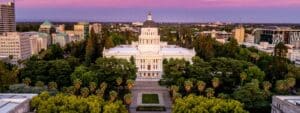Oct. 20, 2010
Robert Gammon
Measure R Is About Climate Change
Backed by environmentalists, Berkeley’s Measure R would help the city meet its landmark climate change goals, but anti-growth activists are trying to kill it.
In many ways, this year’s Berkeley election comes down to one issue: climate change. Environmentalists increasingly agree that dense development near major urban transit hubs is the best way to curb suburban sprawl and combat global warming. The reason is simple. City dwellers have much smaller carbon footprints because they live in smaller homes, and take mass transit, ride their bikes, or walk.
For years, environmentalists in Berkeley have been working with business, labor, and city leaders on a downtown plan that will spur such smart growth. The product is Measure R, an advisory measure on the November ballot. Sponsored by the Sierra Club, Greenbelt Alliance, and League of Conservation Voters, along with the Berkeley Chamber of Commerce and the Alameda County Labor Council, Measure R would give the Berkeley City Council a voter mandate to adopt a plan for a heavily populated downtown core. “In the climate crisis, it’s important to have more residents near transit hubs,” Andy Katz, chair of Sierra Club California, said at a recent downtown debate. “That’s what gets us most excited about Measure R.”
Yet despite the broad-based support for Measure R, the outcome on November 2 is anything but certain. A group of opponents, led by city Councilmen Jesse Arreguin and Kriss Worthington, is working hard to defeat the measure.
Arreguin opposes tall buildings in downtown Berkeley, and argues that any downtown plan should include higher developer fees for open space and transportation, along with requirements for affordable housing. He also argues that Measure R will potentially allow developers to breeze past Berkeley’s landmark preservation law. “It’s going to make it easier,” he said, “to demolish buildings in downtown.”
Although Arreguin calls himself an environmentalist, his demands for downtown likely will block smart growth, Measure R supporters note. Developers aren’t exactly lining up to build in downtown Berkeley, so fees and other restrictions backed by Arreguin and Worthington will make it more expensive to build, thus making development much less likely. For example, Arreguin’s demand that condominium or apartment buildings be no more than 120 feet tall literally means they might not get built at all. That’s because developers say the high cost of building materials required for tall buildings makes it unprofitable to construct them at less than 180 feet in height.
Last year, the city adopted groundbreaking climate-change goals, but without dense development, Berkeley almost assuredly will fail to meet them. In addition, the downtown area will continue to struggle because there won’t be enough people to support small businesses, retail, and the arts. “It’s just so criminal that we have such an underutilized resource in this community,” said Susie Medak, managing director of the Berkeley Repertory Theater and president of the Downtown Berkeley Association, referring to the downtown area.
Arreguin and Worthington are responsible for Measure R being on the ballot. In 2009, the city council voted 7-2, with Arreguin and Worthington voting “no,” to adopt a dense downtown plan. But then Arreguin and Worthington led a signature-gathering effort to referend the council’s vote. Dishonest politicking marred the campaign, as opponents of the downtown plan falsely told residents that it wasn’t “green.” It worked. Opponents eventually gathered enough signatures to either put the plan on the ballot or force the council to kill it.
The council majority later decided to discard the downtown plan, and then worked with environmentalists, business, and labor to come up with Measure R. In another 7-2 vote, with Arreguin and Worthington again voting “no,” the council put Measure R on the November ballot to gauge voter support, and to try to overcome Arreguin’ and Worthington’s staunch opposition.
Measure R softens some of the more controversial proposals in the previous plan. Instead of allowing other buildings of up to 85 feet in the downtown area, Measure R calls for heights of no more than 75 feet. Measure R also would allow for two, 120-foot-tall buildings compared with the previous plan, and it calls for up to three, 180-foot-tall buildings, compared with the prior plan for two. It also would prohibit buildings of 225 feet in height, while previous plans would have allowed up to two of them.
Measure R also calls for energy-efficient buildings that meet LEED-Gold standard or better, and it allows developers to pay fees in lieu of building unneeded parking. The measure also calls for giving developers a “green pathway” that allows a streamlined bureaucratic-review process in exchange for setting aside 20 percent of buildings for affordable housing. In addition, 30 percent of construction workers must be from Berkeley or other cities in the East Bay Green Corridor, which includes Oakland. And despite claims by opponents, it still allows for landmark review of buildings, ensuring that historically important architecture is protected.
Nonetheless, some opponents of Measure R are attempting to employ the same tactics they used in the referendum fight, calling the measure “greenwashing” — an allegation that angers supporters. “The Sierra Club, the League of Conservation Voters, and Greenbelt Alliance would not support this measure if it were ‘greenwashing,'” said Erin Rhoades of Livable Berkeley.
But even if voters approve Measure R, the battle may not be over. At a debate sponsored by the Berkeley Chamber of Commerce, Arreguin would not rule out launching a new referendum campaign if Measure R passes and the council once again adopts a downtown plan he doesn’t like.
###
http://www.eastbayexpress.com/ebx/measure-r-is-about-climate-change/Content?oid=2138573




